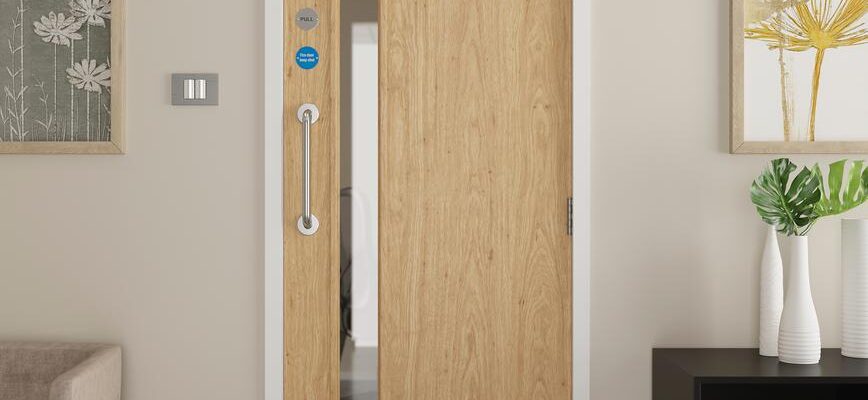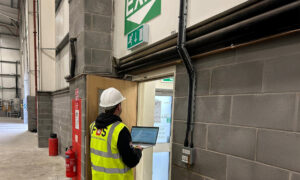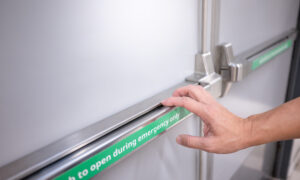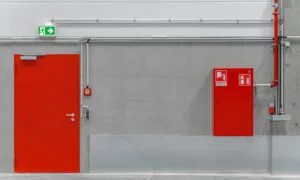In a fire, every second counts. And fire-resistant doors give you valuable minutes to evacuate the building and protect your premises while you’re waiting for the fire brigade to arrive.
The difference between a door that holds back fire for 30 minutes and one that can withstand flames for four hours is huge. And this is where fire door ratings come in.
In the UK, fire doors are rated according to how long they can resist fire and smoke. You’ll see designations like FD30, FD60 or FD120 on certified fire doors. But what do these terms actually mean, and which rating is right for your building?
In this guide, we explain everything you need to know about fire door ratings.
What is a fire door rating?
A fire door rating is a classification that indicates how long a fire door can resist flames in the event of a fire.
The rating (for example, FD30 or FD60) represents the minimum number of minutes the door has been tested to withstand fire under controlled conditions. FD30 means the door offers 30 minutes of fire resistance. FD60 provides 60 minutes of fire protection.
You also find doors that are rated as, for example, FD30s or FD90s. The “s” stands for smoke control and indicates the door can hold back both flames and cold smoke for the specified time.
It’s important to note that fire ratings for doors apply to the complete door set, not just the door leaf. It includes all fire door components, including the frame, seals, glazing, hinges and hardware. If any element fails — or if the fire door installation isn’t up to standard — the door set won’t achieve its rated performance.
What are the different types of fire door ratings in the UK?
There are several different fire ratings for doors. Here’s what each door rating means.
FD30 fire door rating
The most common fire door rating in the UK, FD30 doors provide 30 minutes of protection against fire. These doors are typically used in low-risk commercial buildings and residential properties. You can get FD30 timber fire doors and FD30 steel fire doors.
FD60 fire door rating
FD60 fire doors can withstand fire for at least an hour. They’re designed for higher risk environments like schools, hospitals and high-rise buildings, where there are more people and more time is needed for a safe evacuation.
FD90 fire door rating
FD90 fire doors can withstand fire for 90 minutes. These doors are typically found in large commercial buildings and in industrial environments where flammable materials are stored.
FD120 fire door rating
Providing protection from fire for at least two hours, FD120 fire doors are rarely used in commercial or residential properties. Instead, you’re more likely to find them in very high-risk industrial environments.
FD240 fire door rating
The highest standard of fire resistance, FD240 doors provide a defence against fire for at least four hours. These steel doors are designed for extreme-risk environments where maintaining compartmentation for as long as possible is essential. You can find FD240 doors in places like data centres and power plants.
How are fire ratings for doors determined?
In the UK, all fire doors must be tested and certified according to BS 476-22 (or the European equivalent, BS EN 1634-1).
During testing, a complete fire doorset is installed into a wall to replicate real-world conditions. The door is then exposed to intense heat that simulates a fire.
Independent assessors monitor how long the doorset maintains its stability and integrity — in other words, how long it prevents flames and smoke from passing through.
Once the test is complete, the door is given its official FD rating (or E rating if you’re using the European standard) based on how many minutes it was able to withstand the fire.
Certified fire doors come with a permanent label, usually fixed to the top edge of the door. This label lists key details including the fire door rating, certification number and manufacturer information.
What are fire door rating requirements?
Fire-rated doors play a critical role in a building’s passive fire protection. They help to compartmentalise a building, creating a fire-resistant barrier. This allows people to escape safely while helping to protect the building and the equipment it contains until the fire service gets the blaze under control.
So which fire-door rating is right for your building? Fire door rating requirements depend on several different factors.
Building type
The type of fire door you need depends on your building and what it’s used for.
In small buildings, with limited occupancy and a straightforward escape route, FD30 doors are usually sufficient.
In more complex buildings, FD60 or FD90 doors are more common.
In buildings that contain hazardous materials or provide critical infrastructure, FD120 and FD240 doors are sometimes used.
Location within the building
The location within a building also affects the FD-rating required.
You’re more likely to find high-rated doors along escape corridors and stairwells. These doors help to protect fire escape routes in large buildings.
Rooms that contain valuable or hazardous materials are also more likely to have a high-rated fire door.
Occupancy of the building
The more people you have in a building, the longer an evacuation is likely to take. Depending on the number of fire exits you have for your building, higher-rated fire doors may be necessary.
Also, if your building houses people who would struggle to exit the premises by themselves — for example, patients in a hospital or residents in a care home — you may need to install doors with a higher fire resistance rating.
Fire risk assessment results
A professional fire risk assessment will give you detailed information about your fire door rating requirements. Based on building regulations, fire safety legislation and a building inspection, it will tell you where fire doors are necessary and what fire rating they should be certified to.
Find the right fire-rated doors with Fire Door Systems
At Fire Door Systems, we make it easy to find the right fire-rated doors for your building. From fire safety assessments to fire door installation to fire door maintenance, we provide a complete solution and total peace of mind.
Want advice on fire door ratings? Or struggling to work out which fire doors you need for your premises? Get help from our expert team today.





